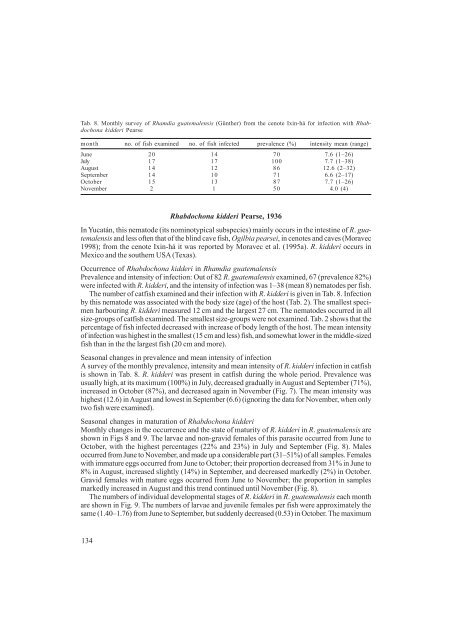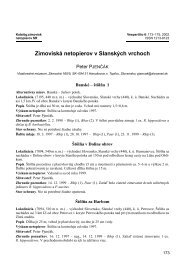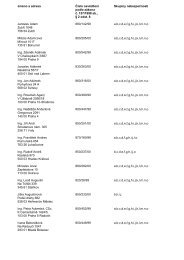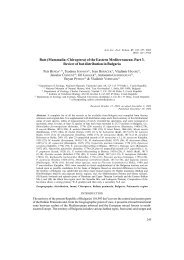Gyraulus parvus (Mollusca: Gastropoda) in the Czech Republic
Gyraulus parvus (Mollusca: Gastropoda) in the Czech Republic
Gyraulus parvus (Mollusca: Gastropoda) in the Czech Republic
- No tags were found...
Create successful ePaper yourself
Turn your PDF publications into a flip-book with our unique Google optimized e-Paper software.
Tab. 8. Monthly survey of Rhamdia guatemalensis (Gün<strong>the</strong>r) from <strong>the</strong> cenote Ix<strong>in</strong>-há for <strong>in</strong>fection with Rhabdochonakidderi Pearsemonth no. of fish exam<strong>in</strong>ed no. of fish <strong>in</strong>fected prevalence (%) <strong>in</strong>tensity mean (range)June 20 14 70 7.6 (1–26)July 1 7 1 7 100 7.7 (1–38)August 14 12 86 12.6 (2–32)September 14 10 71 6.6 (2–17)October 15 13 87 7.7 (1–26)November 2 1 50 4.0 (4)Rhabdochona kidderi Pearse, 1936In Yucatán, this nematode (its nom<strong>in</strong>otypical subspecies) ma<strong>in</strong>ly occurs <strong>in</strong> <strong>the</strong> <strong>in</strong>test<strong>in</strong>e of R. guatemalensisand less often that of <strong>the</strong> bl<strong>in</strong>d cave fish, Ogilbia pearsei, <strong>in</strong> cenotes and caves (Moravec1998); from <strong>the</strong> cenote Ix<strong>in</strong>-há it was reported by Moravec et al. (1995a). R. kidderi occurs <strong>in</strong>Mexico and <strong>the</strong> sou<strong>the</strong>rn USA (Texas).Occurrence of Rhabdochona kidderi <strong>in</strong> Rhamdia guatemalensisPrevalence and <strong>in</strong>tensity of <strong>in</strong>fection: Out of 82 R. guatemalensis exam<strong>in</strong>ed, 67 (prevalence 82%)were <strong>in</strong>fected with R. kidderi, and <strong>the</strong> <strong>in</strong>tensity of <strong>in</strong>fection was 1–38 (mean 8) nematodes per fish.The number of catfish exam<strong>in</strong>ed and <strong>the</strong>ir <strong>in</strong>fection with R. kidderi is given <strong>in</strong> Tab. 8. Infectionby this nematode was associated with <strong>the</strong> body size (age) of <strong>the</strong> host (Tab. 2). The smallest specimenharbour<strong>in</strong>g R. kidderi measured 12 cm and <strong>the</strong> largest 27 cm. The nematodes occurred <strong>in</strong> allsize-groups of catfish exam<strong>in</strong>ed. The smallest size-groups were not exam<strong>in</strong>ed. Tab. 2 shows that <strong>the</strong>percentage of fish <strong>in</strong>fected decreased with <strong>in</strong>crease of body length of <strong>the</strong> host. The mean <strong>in</strong>tensityof <strong>in</strong>fection was highest <strong>in</strong> <strong>the</strong> smallest (15 cm and less) fish, and somewhat lower <strong>in</strong> <strong>the</strong> middle-sizedfish than <strong>in</strong> <strong>the</strong> <strong>the</strong> largest fish (20 cm and more).Seasonal changes <strong>in</strong> prevalence and mean <strong>in</strong>tensity of <strong>in</strong>fectionA survey of <strong>the</strong> monthly prevalence, <strong>in</strong>tensity and mean <strong>in</strong>tensity of R. kidderi <strong>in</strong>fection <strong>in</strong> catfishis shown <strong>in</strong> Tab. 8. R. kidderi was present <strong>in</strong> catfish dur<strong>in</strong>g <strong>the</strong> whole period. Prevalence wasusually high, at its maximum (100%) <strong>in</strong> July, decreased gradually <strong>in</strong> August and September (71%),<strong>in</strong>creased <strong>in</strong> October (87%), and decreased aga<strong>in</strong> <strong>in</strong> November (Fig. 7). The mean <strong>in</strong>tensity washighest (12.6) <strong>in</strong> August and lowest <strong>in</strong> September (6.6) (ignor<strong>in</strong>g <strong>the</strong> data for November, when onlytwo fish were exam<strong>in</strong>ed).Seasonal changes <strong>in</strong> maturation of Rhabdochona kidderiMonthly changes <strong>in</strong> <strong>the</strong> occurrence and <strong>the</strong> state of maturity of R. kidderi <strong>in</strong> R. guatemalensis areshown <strong>in</strong> Figs 8 and 9. The larvae and non-gravid females of this parasite occurred from June toOctober, with <strong>the</strong> highest percentages (22% and 23%) <strong>in</strong> July and September (Fig. 8). Malesoccurred from June to November, and made up a considerable part (31–51%) of all samples. Femaleswith immature eggs occurred from June to October; <strong>the</strong>ir proportion decreased from 31% <strong>in</strong> June to8% <strong>in</strong> August, <strong>in</strong>creased slightly (14%) <strong>in</strong> September, and decreased markedly (2%) <strong>in</strong> October.Gravid females with mature eggs occurred from June to November; <strong>the</strong> proportion <strong>in</strong> samplesmarkedly <strong>in</strong>creased <strong>in</strong> August and this trend cont<strong>in</strong>ued until November (Fig. 8).The numbers of <strong>in</strong>dividual developmental stages of R. kidderi <strong>in</strong> R. guatemalensis each monthare shown <strong>in</strong> Fig. 9. The numbers of larvae and juvenile females per fish were approximately <strong>the</strong>same (1.40–1.76) from June to September, but suddenly decreased (0.53) <strong>in</strong> October. The maximum134








